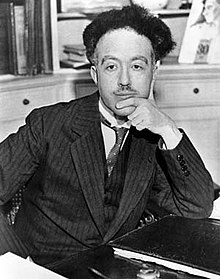
Back Louis de Broglie AN لويس دي بروي Arabic لويس دى بروى ARZ Louis de Broglie AST Lui de Broyl Azerbaijani لویی دو بروی AZB Луі дэ Бройль Byelorussian Люі дэ Бройль BE-X-OLD Луи дьо Бройл Bulgarian লুই দ্য ব্রোয়ি Bengali/Bangla
This article needs additional citations for verification. (August 2019) |
Louis de Broglie | |
|---|---|
 Broglie in 1929 | |
| Born | Louis Victor Pierre Raymond 15 August 1892 Dieppe, France |
| Died | 19 March 1987 (aged 94) Louveciennes, France |
| Education | University of Paris (BA in History, 1910; BA in Sciences, 1913; PhD in physics, 1924) |
| Known for | Wave nature of electrons De Broglie–Bohm theory De Broglie waves |
| Awards | Nobel Prize in Physics (1929) Henri Poincaré Medal (1929) Albert I of Monaco Prize (1932) Max Planck Medal (1938) Kalinga Prize (1952) |
| Scientific career | |
| Fields | Physics |
| Institutions | University of Paris (Sorbonne) |
| Thesis | Recherches sur la théorie des quanta ("Research on Quantum Theory") (1924) |
| Doctoral advisor | Paul Langevin |
| Doctoral students | Cécile DeWitt-Morette Bernard d'Espagnat Jean-Pierre Vigier Alexandru Proca Marie-Antoinette Tonnelat |
Louis Victor Pierre Raymond, 7th Duc de Broglie (/də ˈbroʊɡli/,[1] also US: /də broʊˈɡliː, də ˈbrɔɪ/,[2][3] French: [də bʁɔj][4][5] or [də bʁœj] ⓘ; 15 August 1892 – 19 March 1987)[6] was a French aristocrat and physicist who made groundbreaking contributions to quantum theory. In his 1924 PhD thesis, he postulated the wave nature of electrons and suggested that all matter has wave properties. This concept is known as the de Broglie hypothesis, an example of wave–particle duality, and forms a central part of the theory of quantum mechanics.
De Broglie won the Nobel Prize for Physics in 1929, after the wave-like behaviour of matter was first experimentally demonstrated in 1927.
The 1925 pilot-wave model,[7] and the wave-like behaviour of particles discovered by de Broglie was used by Erwin Schrödinger in his formulation of wave mechanics.[8] The pilot-wave model and interpretation was then abandoned, in favor of the quantum formalism, until 1952 when it was rediscovered and enhanced by David Bohm.[9]
Louis de Broglie was the sixteenth member elected to occupy seat 1 of the Académie française in 1944, and served as Perpetual Secretary of the French Academy of Sciences.[10][11] De Broglie became the first high-level scientist to call for establishment of a multi-national laboratory, a proposal that led to the establishment of the European Organization for Nuclear Research (CERN).[12]
- ^ "de Broglie, Louis-Victor". Lexico UK English Dictionary. Oxford University Press. Archived from the original on 4 December 2020.
- ^ "de Broglie". The American Heritage Dictionary of the English Language (5th ed.). HarperCollins. Retrieved 10 August 2019.
- ^ "De Broglie". Collins English Dictionary. HarperCollins. Retrieved 10 August 2019.
- ^ Léon Warnant (1987). Dictionnaire de la prononciation française dans sa norme actuelle (in French) (3rd ed.). Gembloux: J. Duculot, S. A. ISBN 978-2-8011-0581-8.
- ^ Jean-Marie Pierret (1994). Phonétique historique du français et notions de phonétique générale (in French). Louvain-la-Neuve: Peeters. p. 102. ISBN 978-9-0683-1608-7.
- ^ Cite error: The named reference
louvecienneswas invoked but never defined (see the help page). - ^ The final pilot-wave model was presented in Solvay Conferences and later published, in "Ondes et mouvements" of 1926.
- ^ Antony Valentini: On the Pilot-Wave Theory of Classical, Quantum and Subquantum Physics, Ph.D. Thesis, ISAS, Trieste 1992
- ^ "de Broglie vs Bohm". Excerpts from 1960 book published by Elsevier Pub.Co. Retrieved 30 June 2015.
- ^ O'Connor, John J.; Robertson, Edmund F., "Louis de Broglie", MacTutor History of Mathematics Archive, University of St Andrews
- ^ "History of International Academy of Quantum Molecular Science". IAQMS. Retrieved 8 March 2010.
- ^ "Louis de Broglie". Soylent Communications. Retrieved 12 June 2015.
© MMXXIII Rich X Search. We shall prevail. All rights reserved. Rich X Search